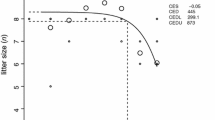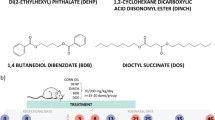Abstract
Evidence suggests that the teratogenicity of the anticonvulsant drug phenytoin (DPH) can result from its bioactivationvia embryonic prostaglandin synthase and/or maternal cytochromes P450. This study examined whether DPH bioactivation and teratogenicity could be reduced by dietary n−3 fatty acids. Female CD-1 mice were fed diets containing 2 wt% safflower oil and 10 wt% of either hydrogenated coconut oil, safflower oil, or a cod liver oil/linseed oil mixture (CLO/LO) for three weeks prior to impregnation and throughout gestation. DPH (55 or 65 mg/kg) was administeredvia intraperitoneal injections to pregnant mice at 0900 on gestational days 12 and 13, and on day 19 fetuses were given teratologic assessments. A similar dietary study evaluatedin vivo covalent binding of radiolabeled DPH administered on day 12, and dams were killed 24 h later. A reduction in DPH-induced cleft palates and a decrease in DPH covalent binding to embryonic protein was observed in the CLO/LO group. Feeding CLO/LO enhanced incorporation of n−3 fatty acids into embryos and inhibited embryonic prostaglandin synthase activity. No differences in maternal hepatic cytochromes P450 activities were observed among dietary treatments. These data indicate that dietary n−3 fatty acids could reduce DPH teratogenicityvia inhibition of embryonic prostaglandin synthase bioactivation of DPH.
Similar content being viewed by others
Abbreviations
- CLO/LO:
-
cod liver oil/linseed oil
- DPH:
-
phenytoin
- FAME:
-
fatty acid methyl esters
- HCO:
-
hydrogenated coconut oil
- PGA2α :
-
prostaglandin A2α
- PGE2α :
-
prostaglandin E2α
- PGF2α :
-
prostaglandin F2α
- PUFA:
-
polyunsaturated fatty acids
- SAFF:
-
safflower oil
References
Wells, P.G., and Harbinson, R.D. (1980) inPhenytoin-Induced Teratology and Gingival Pathology (Hassell, T.M., Johnston, M.C., and Dudley, K.H., eds.), pp. 83–108, Raven Press, New York.
Hanson, J.W. (1976)Teratology 13, 185–188.
Kelly, T.E. (1984)Am. J. Med. Genet. 49, 445–450.
Strickler, S.M., Miller, M.A., Andermann, E., Dansky, L.V., Seni, M., and Spielberg, S.P. (1985)Lancet 2, 746–749.
Harbinson, R.D., and Becker, B.A. (1970)J. Pharmacol. Exp. Ther. 22, 283–288.
Lum, J.T., and Wells, P.G. (1986)Teratology 33, 53–72.
Harbinson, R.D., and Becker, B.A. (1974)Toxicol. Appl. Pharmacol. 22, 193–200.
Pantarotto, C.M., Arboix, M., Sezzano, P., and Abbruzzi, R. (1982)Biochem. Pharmacol. 31, 1501–1507.
Kubow, S., and Wells, P.G. (1989)Mol. Pharmacol. 35, 504–511.
Wells, P.G., Zubovits, J.T., Wong, S.T., Molinari, L.M., and Ali, S. (1989)Toxicol. Appl. Pharmacol. 97, 192–202.
Wong, M., and Wells, P.G. (1988)Teratog. Carcin. Mutagen. 8, 65–79.
Shanks, M.J., Kubow, S., Wiley, M.J., and Wells, P.J. (1989)Teratology 40, 311–320.
Mitchell, M.O., Brennecke, S.P., Saeed, S.A., and Strickland, D.M. (1985) inBiological Protection with Prostaglandins (Cohen, M.M., ed.) Vol. 1, pp. 27–44, CRC Press, Boca Raton.
Juchua, M.R. (1981) inThe Biochemical Basis of Chemical Teratogenesis (Juchua, M.R., ed.), pp. 63–94, Elsevier/North Holland, New York.
Swanson, J.E., Black, J.M., and Kinsella, J.E. (1987)J. Nutr. 117, 824–832.
Clarke, S.D., Benjamin, L., Bell, L., and Phinney, S.D. (1988)Am. J. Clin. Nutr. 47, 828–835.
Sosenko, I.R., Innis, S.M., and Frank, L. (1989)Pediatr. Res. 25, 399–404.
Buege, J.A., and Aust, S.D. (1978)Methods Enzymol. 52, 302–310.
Bradford, M.M. (1976)Anal. Biochem. 72, 248–254.
Folch, J., Lees, M., and Sloane-Stanley, G. (1957)J. Biol. Chem. 226, 497–509.
Juaneda, P., and Rocquelin, G. (1985)Lipids 20, 40–41.
Morrison, W.R., and Smith, L.M. (1964)J. Lipid Res. 5, 600–608.
Klein, K.L., Scott, W.J., and Clark, K.E. (1981)Prostaglandins 22, 623–630.
Labarca, C., and Paigen, K. (1980)Anal. Biochem. 102, 344–352.
Omura, T., and Sato, R. (1964)J. Biol. Chem. 239, 249–258.
Lubet, R.A., Mayer, R.T., Cameron, J.W., Nims, R.W., Burke, M.D., Wolff, T., and Guengerich, F.P. (1985)Arch. Biochem. Biophys. 238, 43–48.
Prough, R.A., Burke, M.D., and Mayer, R.T. (1978)Methods Enzymol. 52, 372–377.
Kinsella, J.E., Broughton, K.S., and Whelan, J.W. (1991)J. Nutr. Biochem. 1, 123–141.
Seher, A. (1984)Arch. Pharmacology Res. 7, 69–80.
Lands, W.E.M., and Byrnes, M.J. (1981)Prog. Lipid Res. 20, 287–290
Codde, J.P., Beilin, L.J., Croft, K.D., and Vandongen, R. (1985)Prostaglandins 29, 895–910.
Burch, R.M., Luini, A., and Axelrod, J. (1986)Proc. Natl. Acad. Sci. 83, 7201–7205.
Kay, E.D., Goldman, A.S., and Daniel, J.C. (1988)J. Craniofac. Genet. Dev. Biol. 8, 179–186.
Hammer, C.T., and Willis, E.D. (1979)Br. J. Nutr. 41, 465–475.
Saito, M., Oh-Hashi, A., Kubota, M., Nishide, E., and Yamaguchi, M. (1990)Br. J. Nutr. 63, 249–257.
Perucca, E. (1987)Pharmac. Ther. 34, 129–143.
Author information
Authors and Affiliations
About this article
Cite this article
Kubow, S. Inhibition of phenytoin bioactivation and teratogenicity by dietary n−3 fatty acids in mice. Lipids 27, 721–728 (1992). https://doi.org/10.1007/BF02536032
Received:
Accepted:
Issue Date:
DOI: https://doi.org/10.1007/BF02536032




